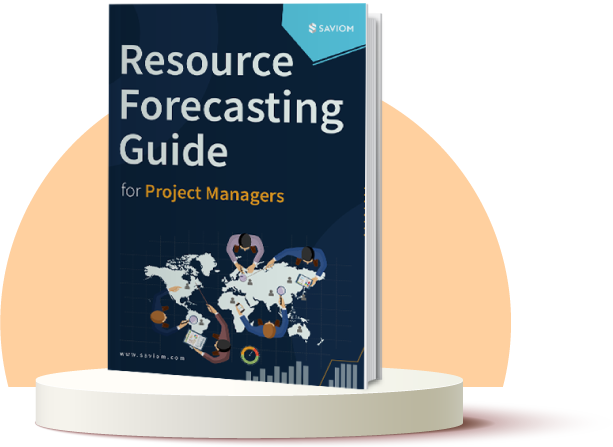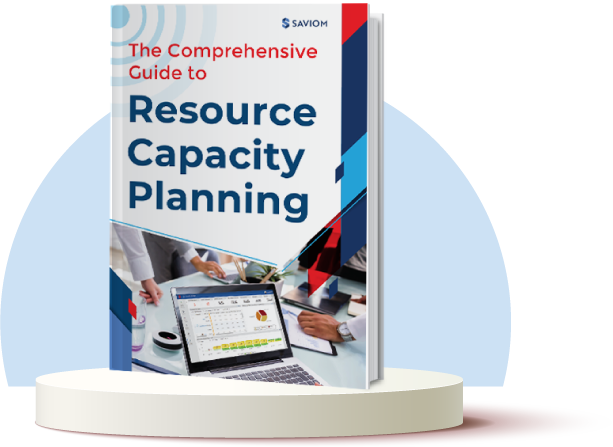An organization’s growth thrives on talent and the competencies of resources. With ever-increasing competition and demand for valued talent, leaders need to stay atop their game and utilize their workforce optimally.
For this, they must balance available resources with the ever-evolving demands of projects to ensure successful project delivery. Since this requires strategic foresight into resource capacity and demand, organizations must implement robust capacity planning solutions.
However, to manage capacity and improve resource utilization across the entire organization, one must first know how to measure resource capacity and demand.
Let’s take an in-depth understanding of some concepts that are imperative to measure Capacity and Demand.


What is resource capacity?
Resource capacity refers to the maximum amount of work, task, or project that can be accomplished by a particular resource over a specified period of time. It is the maximum level of output that a resource is capable of delivering.
Unit of resource capacity can be hours, FTE (Full Time Equivalent), person, days, etc.
How to measure resource capacity?
Resource capacity is measured by the timeline and availability of
● Full-time and part-time employees
● Permanent employees and contractors
● Employees hired and joining on a specific date
● Employees leaving the business by specific dates
Now, let’s consider an example to understand how to calculate resource capacity.
Suppose a company has a policy of working for 8 hours/day and five days/week for a full-time employee. For a full-time employee, the capacity would be 40 hours/week or one FTE or 5-person days.
For a part-time employee working three days/week and 5 hours/day, the capacity would be 15 hours/week. It is equivalent to 0.3 FTE or 1.875 person-days per week.
Now that we know what capacity is, the next step is to understand the various techniques for measuring resource capacity.
What are techniques for estimating resource capacity?
To measure resource capacity accurately, organizations can utilize various techniques. Given below are three commonly used methods:
Historical data analysis:
This technique involves analyzing past project data, including resource allocation, timelines, and outcomes. By examining historical trends, organizations can identify patterns, estimate resource capacity, and determine potential constraints.
Expert judgment:
Expert judgment relies on the insights and experience of individuals or teams familiar with the specific domain or industry. Experts provide subjective assessments based on their knowledge and understanding of resource capabilities, workload distribution, and constraints.
Workload analysis:
Workload analysis involves evaluating the workload of individual resources or teams. It includes assessing task volume, complexity, and duration to estimate resource capacity. This method requires a thorough understanding of project requirements, task dependencies, and workforce capabilities.
Each of these techniques has its strengths and limitations. Organizations can deploy a combination of these methods to obtain a more comprehensive view of resource capacity.
By leveraging these techniques, organizations can gain insights into their current capacity and plan resource allocation effectively. Now, let’s further understand these concepts through an example.
What is resource demand?
Resource demand refers to the number of resources needed to complete a particular task, project, or operation based on its scope and objectives within a given time frame.
The unit of demand for resources is measured in terms of hours, FTE, person days, etc.
Since we are now clear on the concept of the demand management process, let’s learn how to measure demand.
How to measure resource demand?
Resource demand is measured by the timeline and includes the demand for resources required to do
● Project-related work
● BAU, admin, support activities
● Operational activities
Example:
If a company has a full-time working hours policy of 8 hours/day and five days/week, this is equivalent to 40 hours/week.
If an employee is allocated to a project for 48 hours/week, then the corresponding demand is also 48 hours/week. It is equivalent to 1.2 FTE or six person-days per week.
What are the methods for forecasting resource demand?
Organizations can use a combination of statistical and qualitative forecasting techniques to estimate resource demand accurately. Let’s explore each of these methods:
Statistical Forecasting Techniques
Statistical forecasting techniques rely on historical data and mathematical models to predict future resource demand. Some commonly used statistical forecasting methods include:
Time series analysis:
This method examines past data to identify patterns, trends, and seasonality. It applies statistical models such as moving averages, exponential smoothing, and autoregressive integrated moving averages (ARIMA) to forecast resource demand.
Regression analysis:
Regression analysis explores the relationship between resource demand and relevant independent variables, such as sales volume, customer base, or market conditions. It helps identify the factors that influence resource demand and predicts future requirements based on those variables.
Forecasting Models:
Organizations can utilize specific forecasting models designed for resource demand, such as the Holt-Winters method for time series forecasting or the Bass diffusion model for new product adoption forecasts.
Qualitative Forecasting Approaches
Qualitative forecasting approaches rely on expert opinions, market research, and subjective assessments to estimate resource demand. Some qualitative forecasting methods include:
Expert opinion:
Expert opinion involves gathering insights and judgment from individuals with knowledge and expertise, such as HR professionals, managers, department heads, and industry specialists. By soliciting their opinions, organizations can gain valuable insights into factors that impact resource demand, such as industry trends, market conditions, and changes in business strategy.
Scenario planning:
Scenario planning involves developing and exploring multiple hypothetical scenarios that could impact resource demand. These scenarios take into account various factors, such as changes in technology, industry regulations, market fluctuations, and organizational growth or contraction.
Delphi method:
The Delphi method is a structured forecasting approach that involves collecting input from a panel of experts through a series of questionnaires and iterative rounds of feedback. The iterative process allows for convergence on a consensus-based forecast, thus reducing biases and fostering a wide range of perspectives.
Qualitative market research:
Qualitative market research techniques, such as focus groups, interviews, and surveys, can be employed to gather insights from stakeholders within the organization. These methods can provide valuable information about the future needs and expectations of the workforce.
By combining statistical forecasting techniques with qualitative approaches, organizations can obtain a more comprehensive understanding of resource demand.
Read More: Resource Forecasting Guide for Project Managers
After getting a thorough understanding of the basics, let’s understand in detail how to measure and address resource gaps precisely.
How to measure resource capacity vs. demand?
Anticipating and bridging resource gaps is crucial for effective capacity planning in project management. Here’s how you can calculate the gap:
Calculate the resource capacity within the organization
The first step to analyzing the capacity vs. demand gap is calculating the organization’s overall resource capacity. To facilitate this, managers need a birds-eye-view of vital resource metrics such as skill sets, competencies, experience, availability, etc. They must maintain a real-time skill inventory of the organization’s permanent, contingent, full-time, and part-time resources.
Further, managers must closely monitor team dynamics, such as departures and new hires, to assess their impact on team and department workloads. It is essential also to track employee time off, planned leaves, or public holidays during project timelines to gain precise insights into overall capacity.
Forecast the demand for upcoming projects
Next, they must forecast the resource requirements of pipeline projects in terms of number, skills, and timeline. For this, managers must have complete visibility into the project pipeline. Based on that, they can gauge what resources (human and non-human) they need for project execution.
Furthermore, they must consider external factors impacting project demand, such as dynamic market conditions, regulatory changes, and technological advancements. Moreover, firms can rely on past project data to create a more accurate resource estimation for upcoming projects.
Perform a demand gap analysis
Once managers have evaluated the resource capacity and the pipeline project demand, they can perform a demand gap analysis to determine whether the firm has a resource deficit or excess. This involves analyzing the expected resource requirements, such as the number of employees, skill sets, competencies, charge-out rate, availability, etc., against the current workforce competency.
For instance, if a specific skill set vital for the project doesn’t exist within the organization, managers can take pre-emptive steps so that the project stays on schedule. This way, the gap analysis acts as a preventive measure, mitigating last-minute bottlenecks and guaranteeing seamless project execution.
Create a plan to bridge the gap
After the supervisors have identified the resource excess or shortage, they can create a comprehensive plan to address the gap. For instance, in case of skill shortages, firms can organize appropriate training/upskilling programs, implement out-rotation and backfill strategies or recruit contingent/permanent resources depending on the project requirements.
Conversely, when organizations have a resource surplus, they can expedite project timelines or sell extra capacity at a discounted rate. In addition, they can bring forward project start dates and competent resources can be allocated in alignment with organizational objectives.
Review the capacity plan regularly
Since capacity planning is an ongoing and iterative process, firms must constantly review their plan to ensure they are always equipped with an optimized workforce. This involves consistently addressing evolving priorities while identifying skill gaps and other resourcing bottlenecks.
Thus, by regularly reassessing capacity plans, firms can pinpoint areas where specific skills may be lacking to accomplish critical deliverables. This empowers organizations to address potential challenges and future-proof.
Let’s look at some measures firms can adopt to enhance the organization’s ability to anticipate and meet evolving demands with an agile workforce.
Read More: What is Resource Capacity Planning? An Ultimate Guide for Every Project Manager
Best practices for calculating resource capacity and demand
This section explores how organizations can calculate resource capacity and demand to maintain a competitive edge. Let’s go through them one by one.
Centralize all resource-related information
To accurately determine the capacity vs. demand gap, it is crucial to centralize all resource-related attributes, such as skills, availability, utilization, etc., into a single platform. This allows managers to forward plan and assign competent resources to the right job or mitigate any existing resource gaps beforehand to avoid last-minute firefighting. Further, this approach breaks down silos of resource information, thereby minimizing data duplication, promote transparency, and enable more accurate capacity assessments.
Maintain a resource buffer to handle unanticipated changes
Creating a strategic resource buffer is essential for ensuring uninterrupted project progression. By having a readily available reserve of skilled resources, managers can adeptly navigate unexpected shifts in demand and meet task milestones as scheduled. This contributes to enhanced organizational agility, flexibility and resilience within the project framework.
Adapt your capacity planning to meet evolving needs
The business landscape is evolving constantly due to shifting client expectations, technological changes, volatile market conditions, etc. Therefore, managers must adjust the capacity planning process to accommodate these variations. This involves reassessing and adjusting plans to align with changing priorities and unexpected challenges. Further, managers will also need to closely track technological trends to minimize the risk of skill obsolescence. This ensures the firm has an optimized workforce to meet future project demands and maintain a competitive edge.
Foster effective communication & collaboration
Throughout the capacity planning process, it is imperative to facilitate effective and transparent coordination among executives, managers, and stakeholders to ensure everyone is well-informed regarding distinct departmental needs. Additionally, it aligns the entire team with shared priorities and objectives, helps prevent misunderstandings, and facilitates timely adjustments to changing priorities.
Leverage an advanced resource management tool
Relying on legacy tools or simple spreadsheets to evaluate capacity gaps can be challenging and time-consuming. To overcome these limitations, organizations should consider transitioning to resource management software. With the tool’s advanced forecasting and capacity planning module, managers can gain valuable insights into resource excesses and shortages well in advance, facilitating prompt and data-driven decision-making.
Conclusion
Demand management is the holy grail of project resource management that aims to continuously match the demand with capacity for a productive and sustainable business operation.
Moreover, resource capacity and demand are dynamic components requiring continuous monitoring and adjustment. So, embrace the power of accurate measurement and the right tools & technology to thrive in a hypercompetitive business landscape.
Saviom ERM’s capacity planning tool will help you stay ahead of time and take corrective actions by creating insightful resource management strategies.
The Glossary
Read More: Glossary of Resource Workforce Planning, Scheduling and Management
The SAVIOM Solution
SAVIOM is the market leader in Enterprise Resource Capacity Planning software. It has more than 20 years of experience working with highly valued global companies around the world. SAVIOM also provides tools for project portfolio management, professional service automation, and workforce planning software. So, SAVIOM can help your business to establish an efficient system geared towards your specific business challenges.









